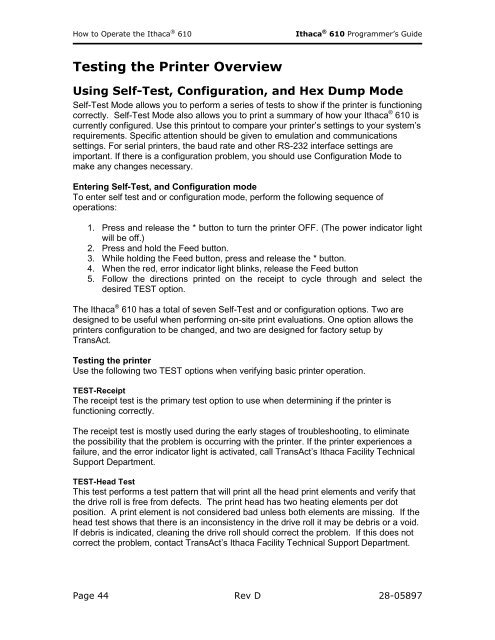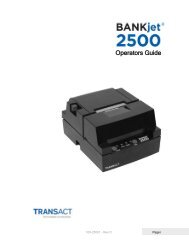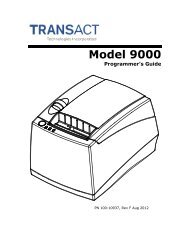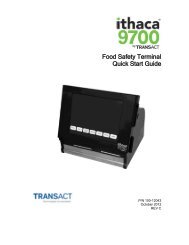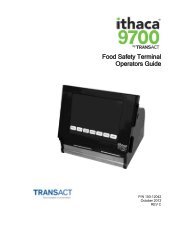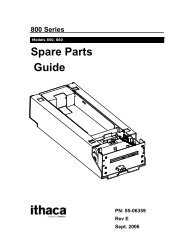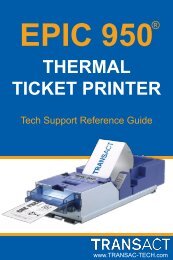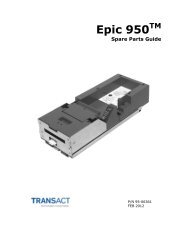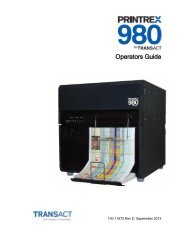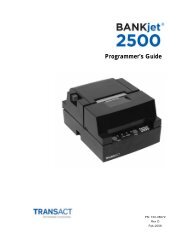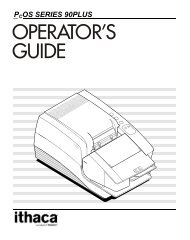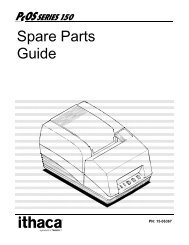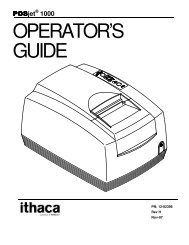Ithaca 610 Programmer's Guide - TransAct
Ithaca 610 Programmer's Guide - TransAct
Ithaca 610 Programmer's Guide - TransAct
You also want an ePaper? Increase the reach of your titles
YUMPU automatically turns print PDFs into web optimized ePapers that Google loves.
How to Operate the <strong>Ithaca</strong> ® <strong>610</strong><br />
<strong>Ithaca</strong> ® <strong>610</strong> Programmer’s <strong>Guide</strong><br />
Testing the Printer Overview<br />
Using Self-Test, Configuration, and Hex Dump Mode<br />
Self-Test Mode allows you to perform a series of tests to show if the printer is functioning<br />
correctly. Self-Test Mode also allows you to print a summary of how your <strong>Ithaca</strong> ® <strong>610</strong> is<br />
currently configured. Use this printout to compare your printer‘s settings to your system‘s<br />
requirements. Specific attention should be given to emulation and communications<br />
settings. For serial printers, the baud rate and other RS-232 interface settings are<br />
important. If there is a configuration problem, you should use Configuration Mode to<br />
make any changes necessary.<br />
Entering Self-Test, and Configuration mode<br />
To enter self test and or configuration mode, perform the following sequence of<br />
operations:<br />
1. Press and release the * button to turn the printer OFF. (The power indicator light<br />
will be off.)<br />
2. Press and hold the Feed button.<br />
3. While holding the Feed button, press and release the * button.<br />
4. When the red, error indicator light blinks, release the Feed button<br />
5. Follow the directions printed on the receipt to cycle through and select the<br />
desired TEST option.<br />
The <strong>Ithaca</strong> ® <strong>610</strong> has a total of seven Self-Test and or configuration options. Two are<br />
designed to be useful when performing on-site print evaluations. One option allows the<br />
printers configuration to be changed, and two are designed for factory setup by<br />
<strong>TransAct</strong>.<br />
Testing the printer<br />
Use the following two TEST options when verifying basic printer operation.<br />
TEST-Receipt<br />
The receipt test is the primary test option to use when determining if the printer is<br />
functioning correctly.<br />
The receipt test is mostly used during the early stages of troubleshooting, to eliminate<br />
the possibility that the problem is occurring with the printer. If the printer experiences a<br />
failure, and the error indicator light is activated, call <strong>TransAct</strong>‘s <strong>Ithaca</strong> Facility Technical<br />
Support Department.<br />
TEST-Head Test<br />
This test performs a test pattern that will print all the head print elements and verify that<br />
the drive roll is free from defects. The print head has two heating elements per dot<br />
position. A print element is not considered bad unless both elements are missing. If the<br />
head test shows that there is an inconsistency in the drive roll it may be debris or a void.<br />
If debris is indicated, cleaning the drive roll should correct the problem. If this does not<br />
correct the problem, contact <strong>TransAct</strong>‘s <strong>Ithaca</strong> Facility Technical Support Department.<br />
Page 44 Rev D 28-05897


